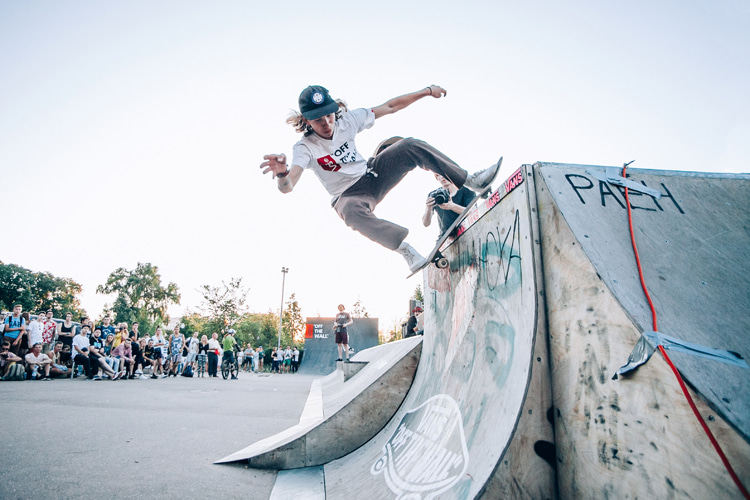Skateboarding is a fun and exciting outdoor sport. The following guide covers the essentials, from choosing the right gear and learning basic moves to building confidence and progressing to more advanced tricks.
Skateboarding has been an activity enjoyed by people of all ages for decades. It has been a great source of exercise, stress relief, and an opportunity to express creativity.
It can also be a daunting endeavor for beginners, who may worry about the physical demands of the sport or feel intimidated by the large number of experienced skaters.
While skateboarding may appear difficult to learn, it can be mastered with patience, practice, and simple tips.
Whether you're a complete beginner looking to try something new or an experienced skater looking to improve your skills, this article will provide a comprehensive guide to learning how to skateboard.
First, we'll cover the basics of choosing the right skateboard and protective gear.
With the right equipment, you'll ride comfortably and safely without worrying about accidents or injuries.
Next, we'll move on to the basic skateboarding moves, such as standing on the board, pushing off, turning, and stopping.
With practice and repetition, these skills will become second nature, and you'll be able to ride with confidence and control.
Once you've mastered the basics, you can explore more advanced techniques like street-based tricks and skate park maneuvers.
Whether you want to do simple ollies and kickflips or more complex grinds and flips, this guide will provide the tips and guidance you need to succeed.
Are you ready to learn how to skateboard? If yes, read on.
With the right knowledge, practice, and patience, tomorrow, you'll be cruising the streets, impressing your friends, and working to become a great skateboarder.
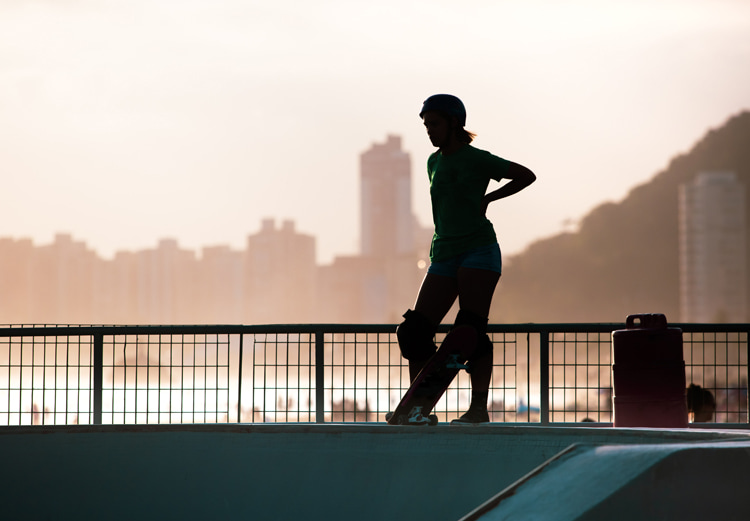
Getting Started to Ride
1. The Right Footwear Is Essential
For those looking to start skateboarding, one of the important things is to invest in quality skate shoes to get the most out of your experience.
Skate shoes provide the perfect balance of support, durability, and flexibility.
Brands like Vans, Airwalk, Converse, or Etnies offer a range of models with flat soles and strong sides designed to give you the grip you need to avoid slips and falls, grip the board, and maintain control.
For the best results, avoid traditional sneakers, sandals, or flip-flops, as they can make it difficult to move your feet around and increase the risk of injury.
Choosing the right skate shoes is the foundation of a good skateboarding experience.
2. Get the Right Board
If you're new to skateboarding, it's important to find the right board.
A good skateboard consists of a deck, trucks, wheels, bearings, and hardware.
The deck is a wooden board and should be chosen based on the rider's size and skill level.
The trucks are the metal pieces that connect the wheels to the deck.
The wheels and bearings allow the skateboard to move, and the hardware is used to assemble the skateboard.
There are many sizes and styles to choose from, such as classic skateboards and longboards (also called cruisers).
Classic skateboards are usually 31 inches long and 8 inches wide, while longboards can be twice as long.
Penny boards are good for leisurely riding down the sidewalk but not for people who are taller than the average 5-year-old or want to do tricks.
When buying a board, make sure it is affordable (between $50 and $150) and set up correctly with the right trucks and wheels for your needs.
Avoid buying cheap boards from Walmart, as they are likely to break and make learning more difficult.
To find the best board for you, visit your local skate shop or look online.
3. Protect Yourself
Getting the right safety gear is important when you're learning to skateboard.
Falls happen, and you don't want to get hurt, so it's wise to invest in a helmet and knee and elbow pads.
Some states, like California, even make it mandatory to wear a helmet on the street.
To ensure your helmet fits properly, measure the circumference of your head above your eyebrows with a tape measure.
Buy a helmet that fits snugly, and don't be embarrassed to wear pads. Protecting yourself from serious head injuries is the most important thing.
4. Find the Right Learning Spot
Getting started on a skateboard is an exciting journey.
To begin, a level concrete or asphalt surface, such as a driveway or parking lot, is an ideal spot to hone your skills.
Check for obstacles like cracks and potholes that could trip you up, and avoid loose stones, which can be difficult to maneuver.
Before taking to the streets, try practicing your balance on grass or carpet for a more secure and less intimidating ride.
Once you've got the basics down, skateparks are great places to perfect your moves.
Head to your local park to see some pros in action and take some tips, but stay out of their way.
5. Get Advice from Experience Riders
If you have your heart set on becoming a skateboarder, seek expert advice.
See if you know anyone who is a seasoned skater who could help you out.
If not, swing by your local skate shop or park and observe someone with more experience.
Ask them if what they are doing is too advanced for you or if you could learn from them.
Skating with friends is a great way to get into the sport, so if you have any skateboarding buddies, tap into their knowledge.
Learning from your peers is way more effective than teaching yourself or searching the web for guidance.
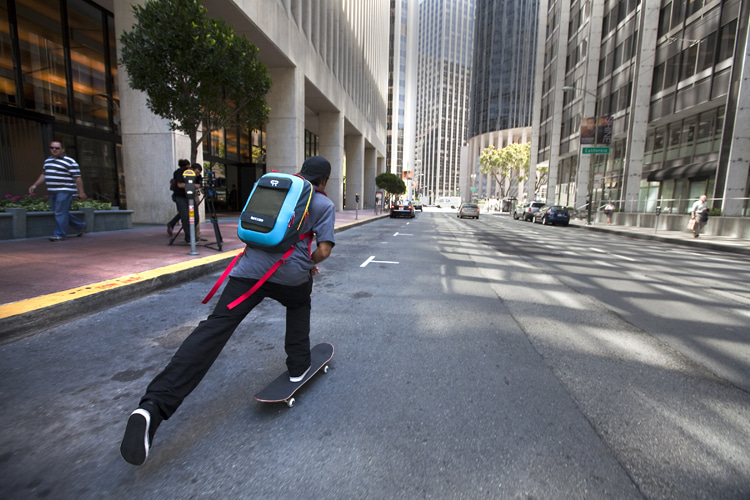
Essentials of Skateboarding: A Beginner's Guide
1. Finding the Balance on the Skateboard
Once you have the necessary equipment, it is time to learn the basics of skateboarding.
Before attempting to stand on the skateboard, you should place it flat on the ground and position your feet accordingly.
Placing your feet in alignment with the truck screws that attach the wheels to the board will help you gain your balance without falling.
It is important to note that a "regular footer" is when you have your left foot forward and your right foot in the back, most likely pushing with the right foot.
A "goofy footer" is when your right foot is forward, and your left foot is in the back, usually pushing with the left foot.
To ensure you're stable, you can rock back and forth a little to observe how the wheels and trucks respond.
This will help you become accustomed to the board and gain confidence.
2. Pushing On Your Skateboard
Start on the right foot by positioning your feet on the board in the proper stance.
Your lead foot should be slightly angled towards the nose of the board, while your back foot should stay slightly behind the tail.
Begin with a gentle push, taking your time and going at a slow pace.
It's important to stay in control and go at a pace that you are comfortable with, as it will be easier to get your balance and stay safe.
Once you have built up some speed, practice putting your back foot on the back of the board before the tail curl.
Use your knees to maintain your balance as you ride.
If you find yourself pushing with your back foot, otherwise known as "pushing mongo," switch it up and try a regular or goofy stance to get used to the motion.
3. Move Faster
As you build up your confidence, give yourself a little push and try to coast a bit faster.
Practice making tiny push-offs with your feet and pivot the board beneath you until you start to slow down.
When that happens, pivot your riding foot straight and push off with the other foot to ride again.
Keep repeating this, and you'll soon feel more secure on the board. Then, increase your speed a little, just like riding a bike.
However, be aware that it's easier to lose your balance when moving faster, so you may need to tighten your trucks to make it harder to turn.
You can also shift your weight forward to help keep your balance.
With practice, you'll eventually learn how to balance and ride faster.
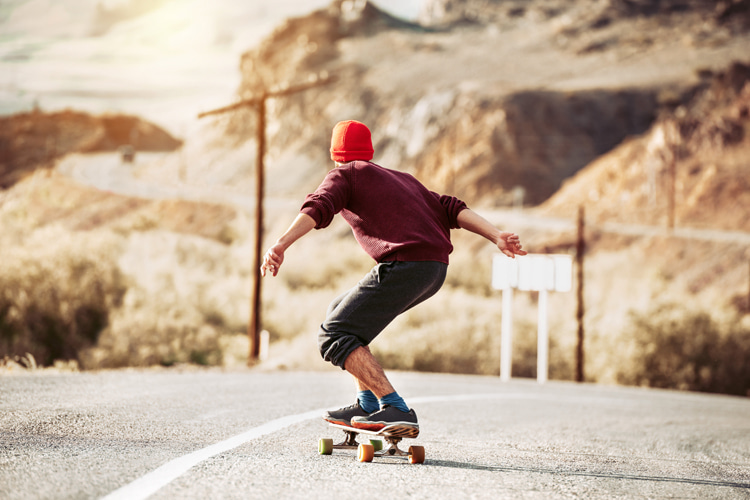
4. Turning Left and Right
To turn your skateboard left and right, you'll need to flex your ankles and shift your weight.
Start by riding with your knees bent, and make sure your center of gravity is close to the ground.
To make a right turn, lean your body forward. To make a left turn, pivot your feet and rotate your ankles back.
The tightness of your trucks determines how much pressure you need to apply.
To adjust the tightness of your trucks, use the large bolt in the center and turn it left or right.
If you have trouble balancing when turning, shift your upper body weight in the opposite direction.
Keep in mind that it is your feet that will pivot the deck and make the trucks turn.
5. Stopping a Skateboard
To slow down and stop, you should start by lightly dragging your pushing foot and gradually increasing the pressure as you reduce your speed.
You should also keep your riding foot on the board. Otherwise, it will keep going.
Longboards often come with built-in plastic brake pads along the tail, which can be used to slow down and stop without damaging the board.
Another technique is to keep your toes on the tail and place your heel behind you, which will drag on the ground instead of the tail.
Before you start skating at higher speeds, it's best to practice getting on and off the board.
Lastly, you can step away from the board with your rear foot and either walk or run away quickly.
6. Try Riding Switch Foot
Learning to ride switchfoot on a skateboard is important if you want to take your riding to the next level.
To do this, you simply switch your feet by placing your back foot in front and your front foot behind.
This skill is essential if you want to master a half-pipe and several other skateboarding tricks.
Taking the time to learn and become comfortable riding switchfoot will help you to become a more well-rounded skater and give you the confidence to try new and more advanced tricks.
7. Learn How to Fall Safely
It's essential to know how to fall safely as a skateboarder.
Wearing protective gear is a must, but learning how to fall properly can be even more important for preventing serious injuries.
When you do take a tumble, extend your arms outward, but keep them loose. This will help reduce the risk of breaking your wrists or ankles.
Additionally, try to roll out of the fall rather than hitting the ground with a splat.
Finally, if you are going too fast and unable to control your board, have no fear of bailing out - simply jump off, land on your feet, or roll into a smooth surface or grass.
Never stick with a board if you know you have no control over it.
8. Watch How Others Ride
Observe experts and pick up techniques and tricks.
Try to skate with someone who has a higher skill level than you. That way, you can gain knowledge from their form or level of proficiency.
If you don't have any acquaintances who skateboard, don't stress.
Simply converse with other riders at your nearest skatepark. Most of them are friendly and willing to lend a hand.
Ask someone you relate to how to attempt a bigger ollie, and check out how to do a different trick or anything else that piques your interest.
Your mentor is now more of a pal than a tutor - they will share their knowledge with you.
If you are trying to learn how to do the move, a great way is to watch it in a video playing in slow motion and observe the footwork.
Also, scrolling through a sequence of skate magazine pictures can be very helpful. Remember that the more you practice, the better you become.
Don't be disheartened if you don't succeed in landing a trick the first or second time.
Just keep practicing and having fun, and you will eventually master it.
The First Tricks
1. Ollie
Start by getting familiar with the motion of popping up the board with your back foot on the tail.
Get a feel for how much pressure you need to send the nose of the skateboard up into the air.
Practice rocking back, stomping on the tail, and lifting the board in one fluid motion.
Trying an ollie for the first time can be daunting, but you can make it easier by standing next to the board and practicing the motion.
Remember to flick down with your ankle and lift the board rather than pushing too hard and preventing the board from rising.
This is the foundation of the ollie, so get comfortable with the motion and build up your confidence before you try it.
Before attempting an ollie while skating, you should practice a stationary ollie.
Start by getting into a low stance on your board, bending your knees, and centering your weight over the trucks.
Move your back foot to the board's tail and push it down firmly, as you would for a manual.
Use that momentum for popping the tail up and completing the ollie.
Once you feel comfortable with this technique, you can start to practice it while in motion.
But be careful - it's easy to take a tumble before mastering it.
The key to achieving an ollie is to time your movement perfectly.
To do so, you should slide your front foot back slightly as you prepare to jump off the board with both feet.
As you do this, you must quickly bring your knees to your chest and press firmly down on the board's tail with your back foot.
This should all be done in one smooth, flowing motion. Think of it like running sideways and jumping over a cone.
It takes practice, but with enough effort, you can master it.
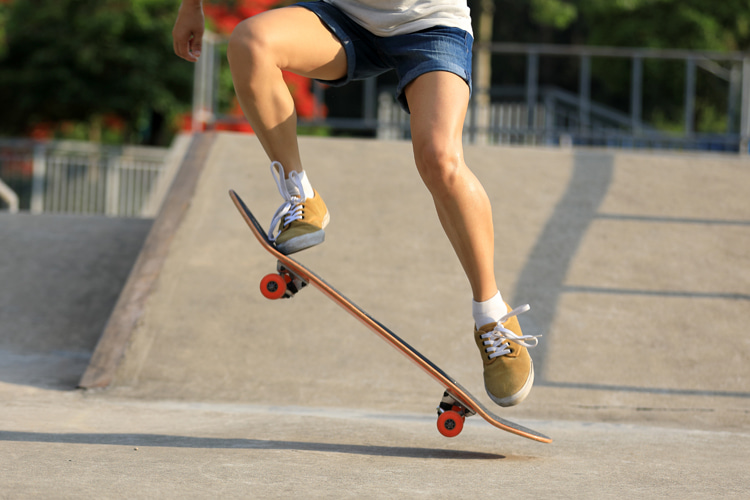
Let's recapitulate.
Begin your journey to an ollie by pushing off the ground with the back foot, allowing the skateboard to pop up in the air.
Quickly follow up with your front foot dragging along the board, so it remains level as it rockets into the air.
This needs to be done almost immediately after you take off to ensure the board remains balanced and you have the best chance of achieving success.
To get the board in the air, start by pushing the board down with your legs straightened.
When you're ready, quickly push the board back to the ground, straightening your legs and landing with your feet above the bolts and knees bent.
This will help you roll away successfully and keep the board from breaking or causing injury.
Don't be afraid to bail out if it doesn't feel right; practice by jumping off the board and landing beside it.
Learning to ollie on a skateboard is one of the essential moves. To get started, practice ten stationary ollies in a row.
Once you've got this down, you can practice it on a skateboard.
Start by pushing off with your back foot, travel at a steady but not too fast speed, and then lower yourself and launch the board as you've done before.
Progressing further means ollying over small objects such as curbs and other street and skatepark obstacles.
The ollie is a foundational skill that many other popping tricks are based on. So, challenge yourself and give it a go.
2. Pop Shove-It
Ready to try the legendary pop shove-it?
Get your board up in the air with an ollie and as you reach the peak of your jump, give a small nudge with the front foot.
This will make the board spin a full 180 degrees. To make it easier, you can also use a "scooping" motion with your back foot.
Watching others do it can help you get the hang of it, but the best way to learn is to try it yourself.
With practice, you'll be doing the pop shove-it like a pro in no time.
3. Kickflip
Are you ready to take skateboarding to the next level by learning to pull off a kickflip?
It may seem intimidating, but with some practice, you can master this classic move.
Start by getting into position, just like a pop shove-it, then give the board a slight nudge and kick the edge that curves upward.
You may need to experiment with different motions to get the board to spin, but don't give up.
There's no denying that this is a challenging trick to master, but with a little bit of dedication, you'll be kickflipping in less than a week.
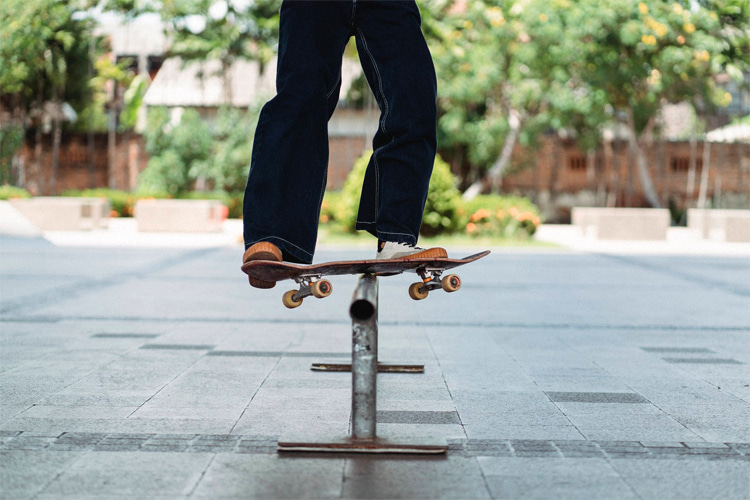
4. Grind
Learning how to grind a skateboard can be complicated, but by taking it step-by-step, you can do it quickly.
Start with a low rail that is no more than a foot high.
Begin by rolling towards it, jumping off your board, and landing with only your feet on the rail, allowing the board to move away from you.
Then practice popping your board up as you jump, still keeping your feet on the rail.
Remember also to approach the rail at an angle so that the trucks don't get stuck on the start of the rail.
When you're ready for the real thing, ollie as high as possible in the direction of the rail and land your feet on the bolts, balancing the board on the rail.
Depending on how you land and the direction you are facing, you will be performing either a boardslide or a 50-50 grind.
When you reach the end of the rail, try to turn the skateboard around if you're in a boardslide or lift the front wheels if you're in a 50-50 grind.
To finish off, you can either land on the bolts or ollie off.
With practice and patience, you will soon be grinding like a professional rider.
5. Drop-In
Head to the skatepark and get ready for your first drop-in. It may require a little courage, but the thrill is worth it.
Position the tail of your board on the coping (the half-pipe' metal edge) and your foot just behind the bolts, far enough back to maintain your balance.
Launch your board, placing your front foot over the bolts.
It is essential that you act quickly and with confidence; otherwise, you will lose your footing.
Remember to lean forward in the motion. Failing to do so will cause your board to slip out from under you.
Your shoulders should remain parallel to the board at all times.
Don't worry about riding down the other side - hop off your board at the top.
Words by Andrew Island | Skateboarder, Surfer and Author
